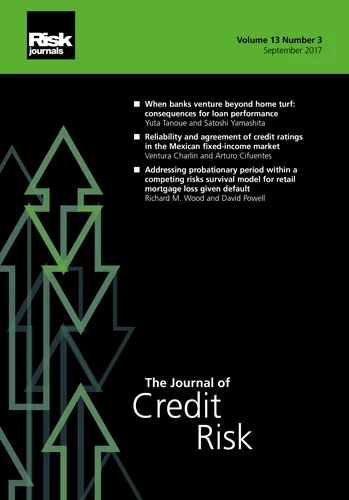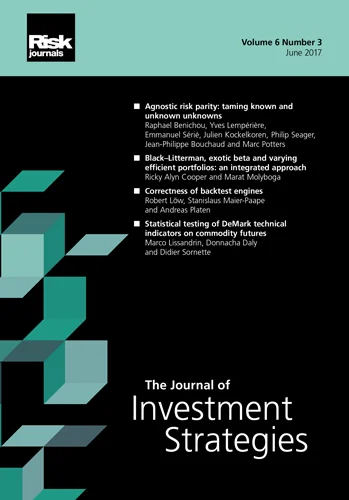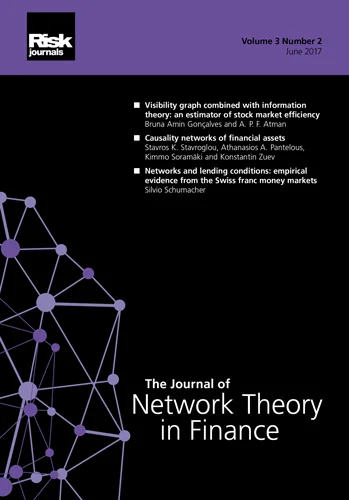Journal of Credit Risk
ISSN:
1755-9723 (online)
Editor-in-chief: Linda Allen and Jens Hilscher
About this journal
With the adoption of machine learning and artificial intelligence in financial institutions, credit analysis methodologies and applications are rapidly evolving.
The Journal of Credit Risk is at the forefront in tackling the many issues and challenges posed by these novel technologies both in and out of periods of financial crisis. Topics include fintech, liquidity risk and the connection to credit risk, the valuation and hedging of credit products, and the promotion of greater understanding in the area of credit risk theory and practice.
The Journal of Credit Risk considers submissions in the form of research papers and technical reports on, but not limited to, the following topics.
- Modeling and management of portfolio credit risk.
- Recent advances in parameterizing credit risk models: default probability estimation, copulas and credit risk correlation, recoveries and loss given default, collateral valuation, loss distributions and extreme events.
- The pricing and hedging of credit derivatives.
- Structured credit products and securitizations, eg, collateralized debt obligations, synthetic securitizations, credit baskets, etc.
- Machine learning and artificial intelligence.
- Credit risk implications of blockchain, crypto currencies and fintech firms.
- Measuring, managing and hedging counterparty credit risk.
- Credit risk transfer techniques.
- Liquidity risk and extreme credit events.
- Regulatory issues, such as Basel II and III, internal ratings systems, credit-scoring techniques and credit risk capital adequacy.
Abstracting and Indexing: Scopus; Web of Science - Social Science Index; EconLit; Excellence Research Australia; Econbiz; and Cabell’s Directory
Journal Metrics:
Journal Impact Factor: 0.3
5-Year Impact Factor: 0.5
CiteScore: 1.1
Latest papers
Estimating the impact of combined correlated credit scorecards
The authors propose an algorithm which can aid the estimation of the validity of combined risk models lacking primary data.
The consequences of the Basel III requirements for the liquidity horizon and their implications for optimal trading strategy
The authors put forward a formula-based approach for determining the optimal liquidity horizon used in scaling the base expected shortfall under Basel III.
A theoretical risk analysis of the "Adogbè" savings product as alternative and decentralized microenterprise financing
This paper discloses the risks associated with Adogbè savings products in Benin.
A credit card fraud detection model based on a stacked temporospatial graph attention residual network
The authors put forward a model based on a stacked temporospatial graph attention residual network dedicated to credit card fraud detection.
Payment card fraud: revealing the EMV impact in the United States and Europe
The authors investigate the adoption of EMV payment cards and how effective they are at managing credit card fraud in the United States and EU.
Enhancing small and medium-sized enterprise factoring: a Stackelberg game-based hybrid pricing model
Hierarchical allocation method for capital: a general method
The authors present a new technique to allocate a bank's risk capital across portfolios and transactions that can be applied to most risk capital types.
Incorporating economic outlook into exposure at default models
This paper outlines a new means to include macroeconomic variables in exposure at default models while satisfying all IFRS 9 expectations.
Public interest assessment in resolution of small and medium-sized banks in the European Union
This paper studies key determinants of public interest assessments in EU bank resolution with a focus on three factors: systemic risk, bank size and bank localness.
A minimum sample size definition for the purpose of loss provision extrapolation in the presence of default correlation
The author applies the Bernoulli distribution to an extrapolation of the capital provision that does not take into account the possible existence of a default correlation.
The effect of environmental, social and governance disclosure on corporate investment efficiency
Investigating the impact of environmental, social and governance (ESG) disclosure on investment efficiency, the authors' findings suggest that nonfinancial disclosure mandates can alleviate capital rationing issues for underinvesting firms.
Variance estimation for the quantification of the margin of conservatism category C
This paper discusses a new estimator for probability of default and compare its performance against two alternative approaches, demonstrating the novel method to have a lower bias and variance.
Metaverse momentum: analyzing financial system risks in an expanding virtual landscape
The authors respond to a lack of regulation in the metaverse, evaluate its vulnerabilities and draw attention to potential future issues that could require supervisory attention.
Agent-based modeling for decentralized autonomous organizations and decentralized finance
The authors propose agent-based modeling for the study of decentralized finance and decentralized autonomous organizations.
Beneath the crypto currents: the hidden effect of crypto “whales”
This paper investigates how different holders of Ether respond to volatility and price movements and shows how challenges and vulnerabilities of traditional finance can be found in the Ether ecosystem.
Fintech adoption and economic growth: exploring the global landscape
The authors argue that increased fintech adoption has a causal relationship with a growth in GDP per capita using data from 112 countries.
How magic a bullet is machine learning for credit analysis? An exploration with fintech lending data
The authors apply machine learning techniques to consumer fintech loan data to assess how such techniques can improve out-of-sample default prediction.
Researching new financial products: using survey evidence to gain insight into buy now, pay later
The authors investigate early adopters of "buy now, pay later" payments and how the use of this service may effect a person's credit.
Did fintech loans default more during the Covid-19 pandemic? Were fintech firms “cream-skimming” the best borrowers?
The authors propose a model which can be used to identify the "invisible prime" consumers from the nonprime pool for fintech loans.
Deciphering bankruptcy risk in fintech firms: exploring key factors and implications
The authors delve into bankruptcy risk of Indian fintech firms, identifying the factors that most impact bankruptcy risk.








